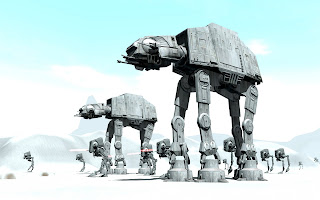 |
| The Necron evolution continues... |
First we have Reanimation Protocols, the rule to replace We'll Be Back. This rule is three paragraphs long in an obvious effort to squelch any and all confusion that made its predecessor infamous. Basically, at the end of every phase you roll a D6 for every dead Necron in a unit that has at least one survivor--it no longer matters what killed the Necron. For every roll of a 5 or a 6, a model rejoins the unit by being placed in coherency of a model that did not just come back to life with Reanimation Protocols. If the unit has to make a fallback move, then you don't get to make any rolls for that phase. This still makes the Necrons very vulnerable to sweeping advance. However, since there is no more distance mechanic as there was with WBB, you can really spread out your units to avoid multi-assaults.
 |
| I'm reusing a picture for a post about a zombie army... it's funny, not lazy |
The next rule is Entropic Strike. This rule replaces disruption fields from the last codex. Any model that suffers an unsaved wound from a model with this special rule immediately loses its armor save for the rest of the game. Since most of the models with armor saves only have one wound, this rule is not particularly terrifying for infantry. However, if you hit a vehicle with a weapon or model with Entropic Strike, then you roll a D6 for each hit. On a 4+, you reduce the armor value of the vehicle by 1 on all armor facings for the remainder of the game. If any of the armor facings is reduced to a value of 0, then the vehicle is immediately wrecked. This gives Necrons another option to destroy vehicles besides glancing them to death. Entropic strike also could make any tank in the game vulnerable to assaults from strength 4 models. How funny would it be to see a Necron Warrior punch a hole through a Land Raider and cause a crater? This rule is really going to change how things are played.
 |
| Such an impressive and imposing model... just waiting to get punked by a 10 point meltagun...=( |
Reanimation Protocols should be considered a success for simplifying the reanimation process. It has pluses and minuses compared to WBB, but it's definitely the better rule based on clarity. I'm also really looking forward to spotting the possible combinations to use Entropic Strike. Necrons have been about getting around your defenses with the inception of the Gauss rule, and Entropic Strike is a rule that stays true to what Necron offense should look like. There's not much to say about Ever-Living, and Living Metal could have been a little more exciting. I don't think losing the defense against lance and 2D6 armor penetration will be that damning for Necron vehicles...at least I hope so.
Overall I like the direction of the Necron codex, and I'm looking forward to examining each list entry and giving you my thoughts.










